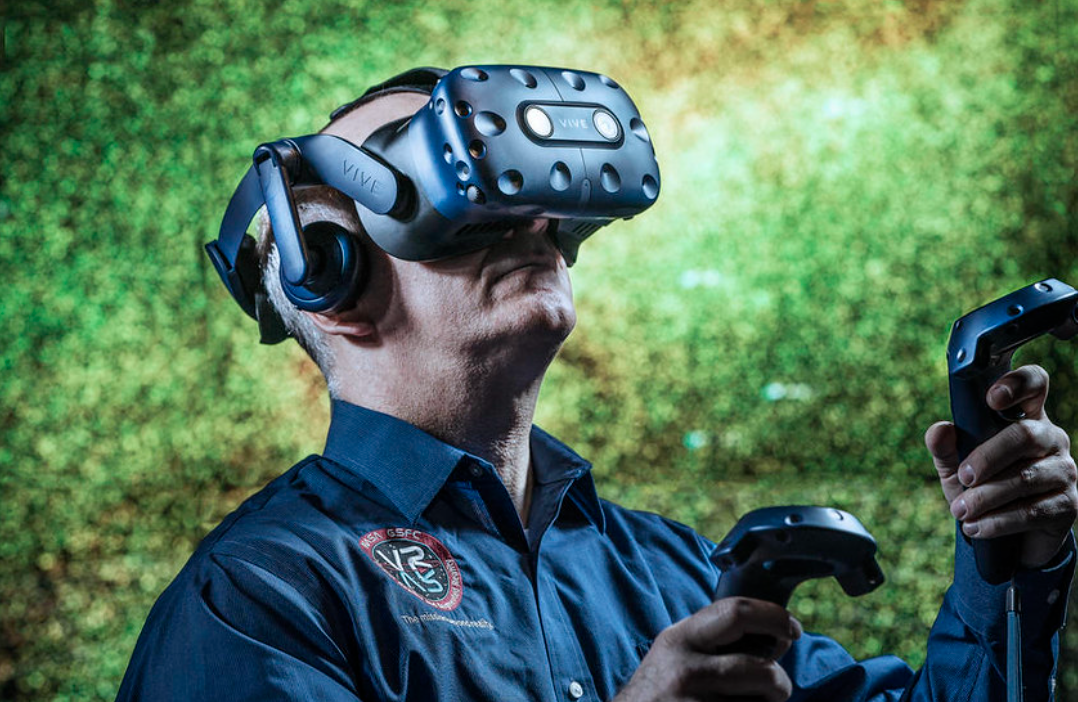Lecture Me! On the use of VR and AI as teacher and leadership training tools
Dr. Liz Coulson’s research offers a human-centered approach to incorporating VR and AI in language learning.
“I kind of think of ChatGPT almost like a group of friends,” Dr. Liz Coulson remarks as she opens her Lecture Me! talk on how virtual reality (VR) and artificial intelligence (AI) can impact the classroom experience. “It’s an aggregate of many, many, many friends coming together with opinions, and ChatGPT organizes those opinions,” she elaborates.
This interactive, tool-based understanding of AI is at the forefront of Dr. Coulson’s approach, as she combines innovative software with teaching and leadership strategies. Dr. Coulson is an assistant professor in the Department of Language Studies at the University of Toronto Mississauga (UTM). Her passions involve incorporating modern technology into a variety of learning environments.
Recently, her research has centred on using AI and VR in language learning to increase engagement and limit intimidation factors. She poses an intriguing question: “Can we simulate situations for language learning that make it less stressful for someone that’s new to a language?”
This is now possible thanks to technological advancements, in addition to the hard work of Dr. Coulson and her team of students. Seven years ago, the Department of Language Studies at UTM was approached by the Syrian Canadian Foundation. The foundation’s members proposed a partnership that would provide English-language learners with new ways of gaining practical experience.
Since then, the proposal has flourished into a research-based project that has delivered English classes to more than 100 newcomers using three different learning methods. The first method is a conventional classroom format, in which a human teacher lectures a group of students. The second method is a VR format where students put on a headset and find themselves in a simulation of a real-life, everyday environment. In this simulation, students can practice English interactions in a less intimidating setting. The third method takes advantage of AI to achieve a similar effect: students enter a chat with a virtual human to develop reading, writing, and comprehension skills.
This practice with virtual humans makes the transition from the classroom to the real world less jarring for newcomers. Being thrown into a situation where everyone is fluent in a language you’ve only just been introduced to is a daunting experience, to say the least, and is no doubt something that any language learner can sympathize with. Dr. Coulson’s research project allows people to develop their confidence and conversational skills with less fear of being judged.
Nonetheless, the development of the project didn’t come without its risks. As with all new technology, testing had to be done to minimize negative health effects, such as dizziness. Additionally, careful thought also had to be put in to ensure students could still interact comfortably with their classmates, a concern solved by limiting VR sessions to 20 minutes in length. This human-centred approach was a key part of the research design.
“I saw it in two ways,” Dr. Coulson explains, “We wanted to build empathy among our students and learners. But we also wanted technology that wasn’t hard to use.” These principles were essential in limiting barriers across generations, and ensuring that anyone, no matter their experience with technology, would be able to participate comfortably. Even with a large focus of the research project being on software, Dr. Coulson remains passionate about viewing technology through a human-oriented lens and doing everything in her power to foster an empathetic, respectful learning environment.
Another principle she upholds, which she credits to Dr. Garfield Gini-Newman, is the idea of the wonder-driven classroom. Regarding her students, she believes that “driving their curiosity to learn and to be excited about learning” is an essential part of the teaching process. Not only is AI an effective tool in the classroom and a revolutionary way of transmitting concepts, but it also draws students in with its novelty. It keeps people engaged and entertained, thus promoting this crucial aspect of wonder.
Yet, even as AI and VR bring overwhelmingly positive contributions to the classroom, it’s essential to remain cautious. “What will be the shockwaves of AI in teaching and learning contexts?” Dr. Coulson asks. She acknowledges that working with new technology can lead to a constant back-and-forth flow: whenever a solution seems near at hand, you get sucked into another problem or difficulty. In the rapidly advancing field of AI, it can be hard for humans to keep up.
VR presents similar challenges: the moment you buy a new headset, it isn’t long before this seemingly new item is considered outdated. As these changes accelerate, remaining on top of the latest developments and using them in a way that aligns with teaching values becomes increasingly difficult.
However, by keeping a positive, resilient attitude, Dr. Coulson remains confident. “What humans create, humans can fix,” she explains. AI may raise new worries, but it’s simply a tool that can be harnessed like any other. By keeping a human-centred approach and treading with caution, Dr. Coulson proves that this tool can enhance the classroom experience, develop language learners’ confidence, and promote an exciting, innovative atmosphere.

